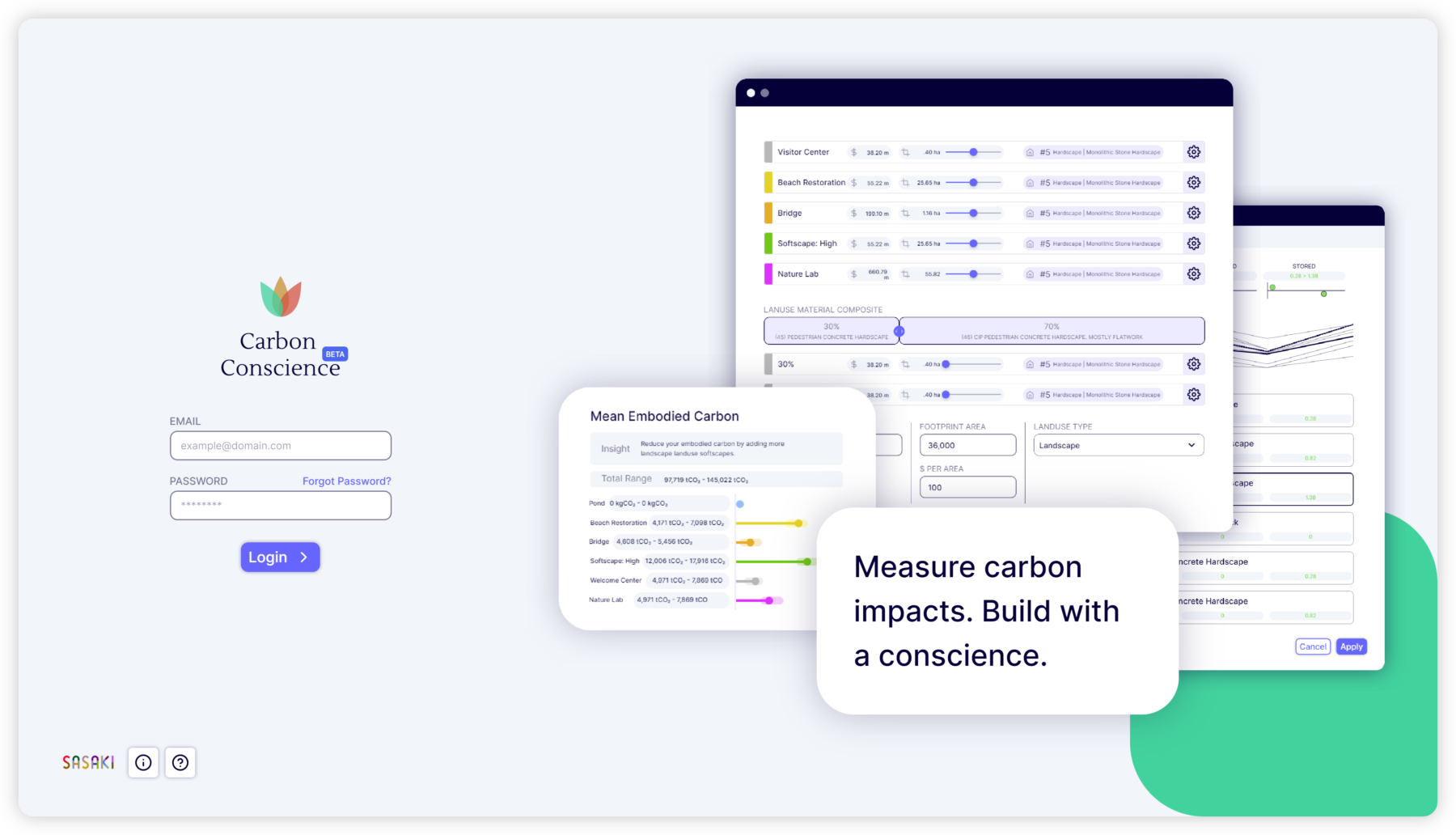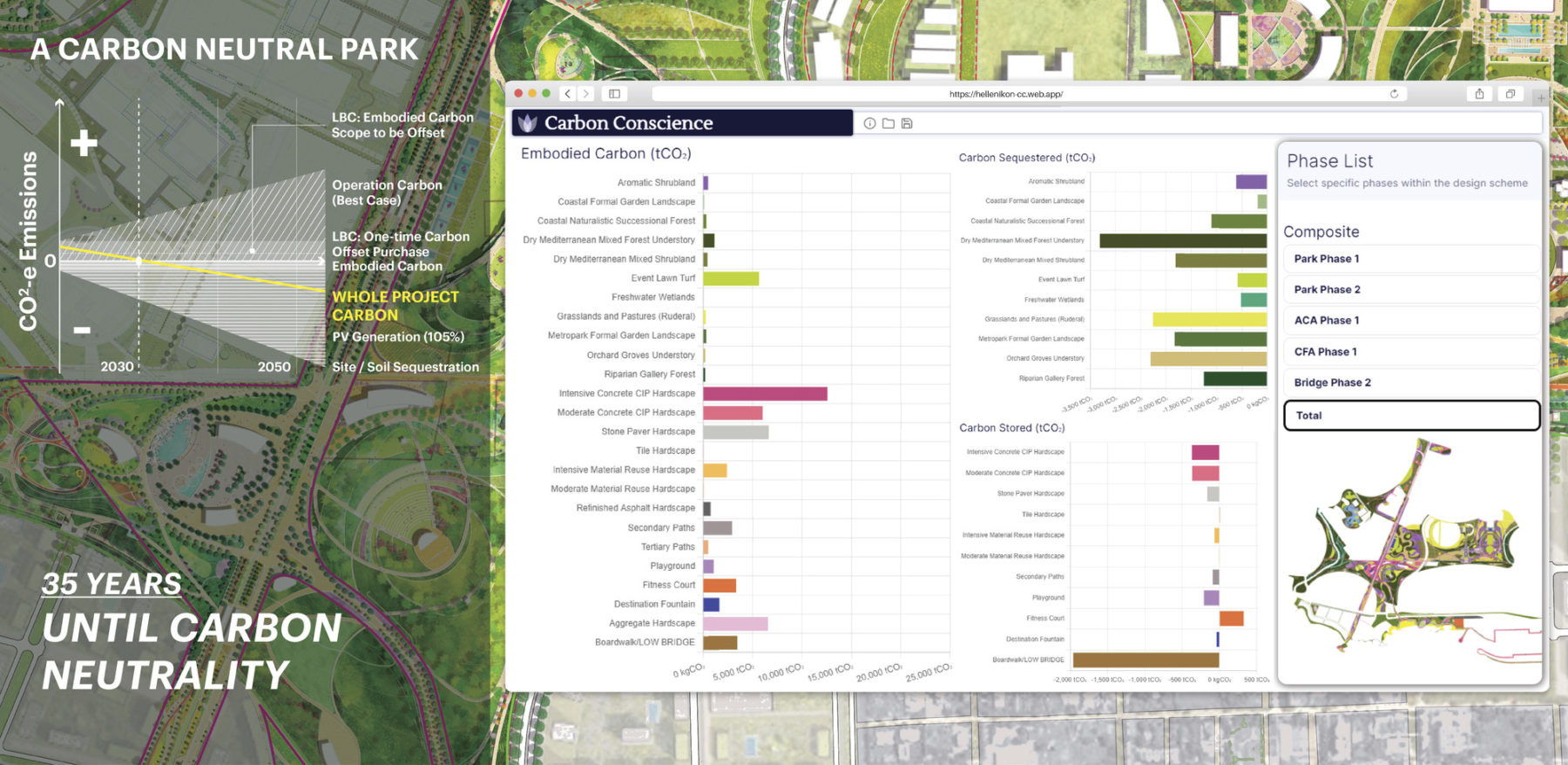Introducing the Carbon Conscience App
A new tool allows planners and designers to reduce embodied carbon from the early stages of planning
 Sasaki
Sasaki

Over the past year, I have been diving deeper into my research on the carbon impacts of the built environment as part of my fellowship with the Landscape Architecture Foundation. This research brings together site and architectural datasets so that early decisions in the design process can be informed by potential carbon impacts of big design moves and framework plans.
The more I learn, the more I realize how much we as designers are missing about reducing emissions on projects. But I see a path forward.
My work has involved reading broadly on carbon factors of various building materials, construction methods, sequestration rates of various ecosystems, and interviewing designers and scientists. All of this research helps inform the updated version of Sasaki’s Carbon Conscience App, a tool to reduce embodied carbon from the early stages of planning, and contributing to the on-going work for the American Society of Landscape Architects Climate Action Plan.
I have had the opportunity to apply what I’m learning to project work in real time: to test, reassess, calculate, and try to develop creative solutions while bringing clients along with me. This has included figuring out how to use over 150,000CM of waste concrete and masonry demolitions in both ‘up-cycling’ and ‘down-cyling’ strategies at the Ellinikon Park, which will be Europe’s largest coastal urban park. Other strategies included large scale soil reuse, a demonstration salt marsh restoration project, reforestation, concrete reduction, and local material sourcing. Developing an understanding of carbon sensitive design is radically transforming my practice.

The design team used Sasaki’s Carbon Conscience tool and Pathfinder to assess the carbon impacts of each design decision made for the Ellinikon Park
I know we can do better on the work we are already delivering. There are lower-impact carbon decisions we can make in practically every specification and product selection we make, including how we approach preservation and material reuse. But that will only take us part of the way toward zero-embodied carbon goals.
I think the future of carbon neutral development will require careful material choices, new tools like the Carbon Conscience app, and industry standards and commitments for benchmarking and reporting…and it will also have to include off-site investments in restoration and preserved ecosystems, such as reforestation or wetland restoration. This could be an exciting possibility for city agencies and mayors to consider. As of right now, the living environment (natural systems, such as forests, wetlands and prairie, and their soils) is the only place where we have the ability to contribute to carbon drawdown in an economically viable way through carbon sequestration.
The challenge of zero-embodied carbon is compounded by the fact that the locations where we want to encourage development are in existing cities, with limited space for onsite reforestation or other sequestration strategies. It’s optimal to concentrate development in cities, because then we have the greatest potential for low operational carbon development by tying into existing infrastructure, mass transportation, and potential for adaptive reuse of structures. However, this commitment to density usually means our on-site landscapes will not have the vast reforestation potential we would need to effectively balance our carbon budgets within our project limits of work.
Design is an optimistic act.
Can we reconnect the urban to rural economies in a way that isn’t merely extractive but instead creates a channel for reinvestment? I imagine a future where urban projects invest in rural restoration: Boston in the Berkshires; New York City in Upstate New York; São Paulo in the Mata Atlântica; Athens in the Peloponnese. I see a potential arc of history where we use reforestation and wetland restoration as a stop-gap strategy to balance our projects in the short-term, and in time, when the gears of greater industry shift to renewable resources for transportation and fabrication are viable, those forests may be part of a sustainable cycle of building materials that continue to store carbon in the built environment. I think the time is coming when we need to consider carbon in the way cities considered water infrastructure in the 19th century–as a regional resource, and invest in supporting regional landscapes to create a sustainable future.
Design is an optimistic act, and at times it can be hard to reconcile our complicated role in the anthropocene with our hopes for the future. The key to achieving carbon neutrality and zero-embodied carbon goals will require being critical, thoughtful, learning from the past, and working together to change our future.
I hope we can build our way out of climate change.